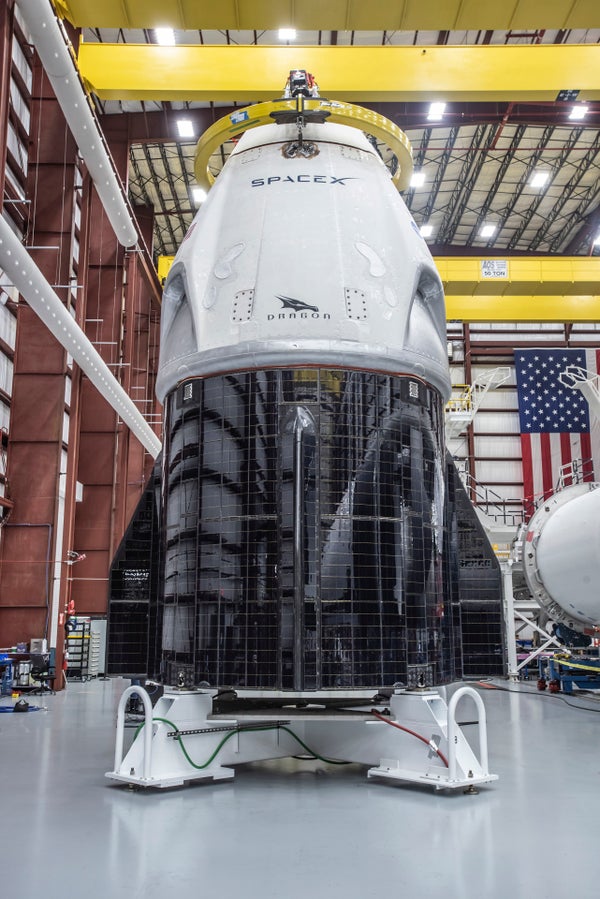A test version of SpaceX’s new astronaut taxi, dubbed the Crew Dragon, suffered some kind of an anomaly during an engine test Saturday (April 20) at the company’s facilities at Cape Canaveral Air Force Station.
According to Florida Today, large plumes of smoke were seen emanating from the area, indicating something had gone wrong. There were no injuries caused by the anomaly, which is now under control, according to officials with the 45th Space Wing based at the Air Force station.
“Earlier today, SpaceX conducted a series of engine tests on a Crew Dragon test vehicle on our test stand at Landing Zone 1 in Cape Canaveral, Florida,” a company spokesperson told Space.com in a statement. “The initial tests completed successfully but the final test resulted in an anomaly on the test stand.”
On supporting science journalism
If you're enjoying this article, consider supporting our award-winning journalism by subscribing. By purchasing a subscription you are helping to ensure the future of impactful stories about the discoveries and ideas shaping our world today.
SpaceX plans to use its Crew Dragon capsule to ferry NASA astronauts to and from the International Space Station. The capsule successfully flew for the first time in March. During the uncrewed mission, the spacecraft docked itself with the space station and then returned to Earth, splashing down in the Atlantic Ocean.
BREAKING: #SpaceX Crew Dragon suffered an anomaly during test fire today, according to 45th Space Wing. Smoke could be seen on the beaches.
"On April 20, an anomaly occurred at Cape Canaveral AFS during Dragon 2 static test fire. Anomaly was contained and no injuries." pic.twitter.com/If5rdeGRXO
— Emre Kelly (@EmreKelly) April 20, 2019
That first flight was a major milestone for SpaceX, and one it needed to complete before Dragon can carry people. Since its return, the company has been busy preparing the vehicle for its next task: an inflight abort test.
This crucial test will demonstrate that the capsule is capable of keeping astronaut crews safe should something go wrong during the launch into orbit. (The system is similar to the emergency abort system on the Soyuz rocket, which saved two astronauts during a mishap last October.) SpaceX was planning on conducting that test sometime in June.
During the test, eight SuperDraco engines—which are embedded in the Dragon’s hull—will fire, demonstrating that the spacecraft can pull itself away from the rocket. Designed to keep a crew safe, this feature will only be used in case of an emergency during flight, but SpaceX must show it works properly. SpaceX performed a successful pad abort in 2015 using the system.
SpaceX planned to use the same Crew Dragon test vehicle that it flew in March, during the upcoming abort test. Though it’s not clear if that same Dragon was the one used in Saturday’s test, and SpaceX hasn’t said yet which engine was to blame for the anomaly.
But SpaceX and NASA are investigating the incident.
“Ensuring that our systems meet rigorous safety standards and detecting anomalies like this prior to flight are the main reasons why we test,” SpaceX said in the same statement. “Our teams are investigating and working closely with our NASA partners.”
It’s not immediately clear just how this incident will affect SpaceX’s timeline for launching crew.
Following the Crew Dragon’s successful first flight, the company was hoping to carry its first crew of Bob Behnken and Doug Hurley later this year. But that schedule could be delayed depending on how serious the issue turns out to be, and how much time is required to address it.
SpaceX is one of two companies building space taxis for astronauts under a NASA contract. Boeing is also developing its own crewed spacecraft, the CST-100 Starliner capsule, to ferry astronaut crews to the space station. The first test flights of that vehicle are also expected later this year.
Copyright 2019 Space.com, a Future company. All rights reserved. This material may not be published, broadcast, rewritten or redistributed.
